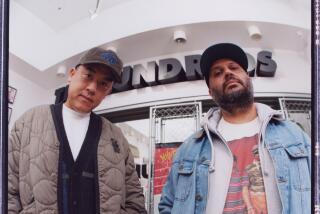How two friends built Revolve into a fashion empire with Instagram influencers
Two young tech co-workers named Michael, who knew absolutely nothing about fashion, unexpectedly found themselves in the rag bin of the dot-com bust at the beginning of the century.
Now they’re running one of the fastest-growing e-commerce clothing companies in the nation: Revolve Group. It was valued at nearly $1.5 billion when it recently went public and, despite a snag here and there, is headed to more than $600 million in sales this year.
Michael Mente, 38, and Mike Karanikolas, 41, are co-chief executives of Revolve, whose initial public offering in June was one of the year’s most successful. Shares opened on the New York Stock Exchange at $25.16, almost 40% higher than the $18 asking price. The Cerritos company raised $211.7 million.
Revolve is only one of the fashion e-tailers harnessing the social media marketing juggernaut to sell to young and urban customers, but it’s the first to pull back the dressing room curtain to give the world a look at its financial underpinnings.
In lieu of traditional advertising, Revolve uses much of its marketing budget to pamper a revolving group of about 3,500 Instagram influencers — including Kendall Jenner, for a time — for wearing its brands as well as the designer names it carries. Revolve, which has 3.3 million Instagram followers on its primary account alone, focuses on selling apparel, shoes and accessories to millennial and Generation Z women and men, adding beauty products nearly three years ago.
None of that seemed likely in 2003, when the company was founded.
E-commerce was in its infancy. Facebook, Instagram and the iPhone hadn’t made an appearance yet. The term influencer didn’t come into widespread use until 2015.
“It was a new world and a new opportunity with the internet and online commerce starting to change things,” Karanikolas recalled of those early days.
“There was a large and growing interest in apparel online. But there weren’t really that many players doing it or doing it well. We felt like we could come out of the gates with a better approach and then continue to build on that.”
Karanikolas and Mente had planned to ride the tech industry dot-com boom that had begun in 1995.
Mente was in an entrepreneurship program at USC when he dropped out to join software company NextStrat in Los Angeles. Karanikolas was hired by the same company in 2000, after earning a degree in computer engineering at Virginia Tech.
As the youngest employees at the company, the two 20-somethings quickly bonded. But the stock market downturn that began in 2000 turned the boom into a bust. NextStrat was part of the carnage.
Mente and Karanikolas were out of a job, but had gained valuable insight about themselves and how well they worked together.
“We were both very analytical,” Mente said, which helped them home in on an idea for a new business.
“Technology was something we’d just grown up with. Data was something we were comfortable with,” Karanikolas said. “And it really helped us spot opportunities consistently, I think, before a lot of the rest of the marketplace.”
The pair’s deep dive into keyword searches and online behavior divulged something they hadn’t considered before, well before some longtime fashionistas and clothing industry veterans noticed it. Even in 2003, fashion shoppers were growing weary of having to trek to bricks-and-mortar stores to shop for clothing, unsure of whether they would find what they were looking for, Karanikolas said.
Neither said they were worried about their lack of fashion experience. In a sense they considered it an asset.
Data and analytics would drive their choices, becoming part of their “trend forecasting algorithms” that incorporate “data from analysis of thousands of styles, dozens of attributes per style” and the constant accumulation of customer interactions, Mente said.
“For us, there’s no such thing as fear of failure with experimentation,” he said, “because the data that we gain from this failure also ultimately helps us improve and assess, then ultimately make the algorithms better.”
A plan was hatched for Revolve as an online sales platform for a broad lineup of existing fashion brands. The nascent firm got a boost from another key change, the “shift from fashion magazines to blogs,” which were the influencers of their day, Mente said.
“Those early bloggers were perfectly positioned to take advantage of a long-term social media wave,” he said. “We were working with influencers when they were still called bloggers, before Instagram. That strategy revolutionized our business.”
Rumi Neely of Fashion Toast “had one of the bigger audiences in the early days. It was a natural fit for us to work with her first,” Mente said. The timing was also crucial. Revolve began working with Neely and other bloggers in 2009, amid the worst economic downturn the nation had seen since 1929.
Revolve survived in part because the fashion blogger network kept shoving business its way, Karanikolas said.
“We were profitable in 2009,” he said. “We came out stronger than we entered it because a lot of our competition didn’t make it through the recession. And that 2009-2010 time period is when the smartphones began gaining more share of the online search traffic and where the interest in bloggers starting picking up.”
Revolve continued to evolve as Mente and Karanikolas kept a close eye on what was trending.
“In this day and age with the democratization of content production, we can create imagery that really connects with the consumer on an emotional level, delivers our core message of aspiration and a great, happy lifestyle, and ultimately do it in a way that’s more authentic,” Mente said.
Beginning in 2012, the company started holding events for its bloggers and early influencers.
Experts say that Revolve, by developing relationships with a huge number of influencers, some with 30,000 or fewer followers, is insulating itself from the harm that might be caused by any one of them suddenly becoming an embarrassment.
“Big celebrity influencers aren’t necessary. Companies don’t need to rely on them,” said Stacy Jones, chief executive of Hollywood Branded, an agency that helps clients negotiate the often tricky choices of which influencers to use.
“The new advent,” Jones said, “is the nano-influencer, anyone that has from 500 to 10,000 followers. Their followers are part of their social circle. They know who they are. They’re friends. They went to college with them. They’re family members, co-workers. When you go down that funnel, to the smaller levels of influencers, you get higher consumer engagement.”
Revolve cultivates and rewards its influencers in a variety of ways. Influencers can get cash or credit to help them purchase Revolve merchandise, or gifts of clothing, which they can then use on their social media pages, according to the company’s securities filings.
The company hosts more than 100 social events annually — one of its biggest and most exclusive (that is, celeb-laden) parties happens every year at the same time as the Coachella music festival. It also sends influencers on trips to enviable vacation spots around the world, all designed to maximize Instagram-worthy moments in clothing sold by Revolve.
In 2017, Revolve began hosting an annual awards ceremony to help convince influencers that they were part of a larger business family. The awards included YouTube Channel of the Year, BFFs of the Year, Best Influencer Brand and Best Beauty Influencer.
It’s been working. Revolve has been profitable for the last three years and revenue has increased consistently, reaching $30.6 million in net income on $498.7 million in net sales in 2018.
“The business has been around for a long time. It’s one of the few e-commerce companies that is actually profitable,” said Aaron Kessler, senior research analyst at the San Francisco office of Raymond James & Associates.
One of its bigger problems might be trying to find the next big idea.
“The combination of fashion and technology gives Revolve a unique business model and investor proposition as a public company,” said Denise Lee Yohn, brand leadership expert and author of “What Great Brands Do.” “Revolve’s strategy has been a smart one so far, but it needs to be looking for the next wave to ride if it wants to offset these risks and retain its position as a pioneer.”
Revolve also must compete for attention — from customers, influencers and designers — with the likes of Fashion Nova, another popular fashion e-commerce operation, which is based in downtown Los Angeles. Rapper Cardi B’s second Fashion Nova collection reportedly sold more than $1 million within 24 hours of its spring debut, according to TMZ.
Revolve, which has nearly 1,000 employees, is run less like a fashion company and more like a tech company that sells clothing, with its own data scientists and engineers.
“Because we didn’t come from a fashion background,” Karanikolas said, “we were building proprietary systems, software that was telling us what to buy and how much as far back as 2003. Since then, what we have is much more sophisticated and evolved. We’ve built a really tremendous team of technical talent.”
Revolve has also cultivated several designers of its own whose items are sold directly through the online platform. The e-tailer recently announced the launch of brand collaborations with two of its most popular influencers, Song of Style with Aimee Song (who has 5.3 million Instagram followers) and the Camila Coelho Collection (Coelho has 8.2 million followers).
Dresses are Revolve’s biggest-selling item. The average order last year was $279 and 79% of the site’s sales were at full price, the company said.
Mente is in charge of marketing and in-house fashion lines. Karanikolas runs the technology and logistics side of the business. The two own a combined 56% stake in the company and control more than two-thirds of the firm’s voting shares through a separate entity called MMMK Development.
Revolve, which offers about 1,000 new fashion items a week for sale, said in its stock prospectus that its proprietary technology is “turning the fashion cycle from a predictive art to a data-driven science.”
Investors reacted with enthusiasm.
The stock closed as high as $46.96 a share just 12 days after the IPO, but fell sharply this month after Revolve’s first earnings report as a public company revealed a surprise quarterly loss of $28.1 million brought about by a stock repurchase. (Revolve had net income of $10.5 million in the year-earlier quarter.) Revenue of $161.9 million, up 23%, beat analysts’ expectations.
The stock closed Friday at $23.01 a share, down 9.5%.
“The quarter was quite good. By our estimates they beat revenues,” Kessler said. “Tariffs here are a bit of a concern for investors,” because much of the clothing sold on the site is made in China and India. “That’s something to watch going forward.”
Mente said the sobering experiences of the dot-com crash and the Great Recession have shaped how they view their business, including the stock’s recent gyrations.
“The short term doesn’t really affect us that much,” he said. “And I think ultimately that’s been core to what got us here and will be core to what drives our success in the future.”







